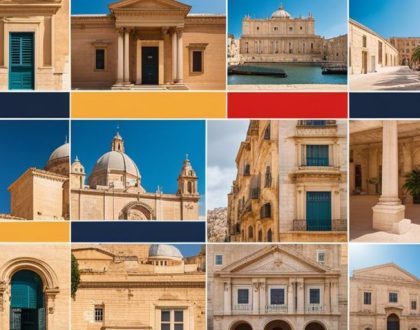Malta’s Tourism Boom

In October 2023, the picturesque island of Malta witnessed a remarkable surge in tourism, with the total number of nights spent by visitors soaring by an impressive 30.7% compared to the same month in 2022, ultimately surpassing the 2 million nights milestone. This surge paints a vibrant picture of Malta’s growing appeal as a travel destination.
Influx of Tourists: Breaking Down the Numbers
Tourist Demographics
According to data released by the National Statistics Office (NSO), Malta played host to a total of 313,705 tourists in October, with 283,595 of them embarking on their journey for leisure purposes, while 20,375 visited for business-related matters. Delving into the demographics, the majority of visitors belonged to the 25-44 age group, constituting an impressive 37.8% of the total, closely followed by the 45-64 age bracket at 34.4%. Residents from the United Kingdom, Italy, and Germany collectively made up 44.1% of the total inbound tourists.
Accommodation Trends
A significant 85.2% of the total guest nights were spent in rented accommodation establishments, showcasing the diverse range of lodging options available to tourists. On average, visitors chose to extend their stay, spending 6.6 nights exploring the charms of Malta.
Economic Impact: Tourism Expenditure Soars
The economic impact of this surge in tourism is noteworthy. Tourist expenditure in October exceeded an impressive €300.8 million, reflecting a substantial 39.0% increase compared to the same month in 2022. The average expenditure per night was estimated at €145.9, underscoring the economic vitality of Malta’s tourism sector.
Year-to-Date Progress: A Continued Ascendancy
Inbound Tourists
Expanding our perspective to the first ten months of 2023, the cumulative number of inbound tourists reached an impressive 2,599,155. This marks a substantial 31.6% increase compared to the same period in 2022, indicating sustained and robust growth in Malta’s tourism sector.
Nights Spent
Total nights spent by tourists during this period increased by 23.3%, reaching almost 17.8 million nights. This sustained growth in the duration of stay signifies Malta’s evolving status from a brief stopover to a destination where visitors choose to linger and explore.
Expenditure Landscape
The economic impact of this prolonged tourism surge is reflected in the total tourist expenditure for the first ten months of 2023, which amounted to a staggering €2.4 billion. This marks a substantial 34.5% increase from the corresponding period in 2022. The expenditure per capita rose to €914 from €894 in 2022, indicating not only an increase in the number of visitors but also a rise in the spending capacity of individual tourists.
Future Implications and Sustainability Measures
As Malta continues to bask in the limelight of its burgeoning tourism sector, the island grapples with the challenge of maintaining this growth sustainably. Striking a balance between economic benefits and environmental conservation becomes paramount to ensure that Malta remains an attractive destination for generations to come.
Balancing Act: Sustainable Tourism Practices
Malta can capitalize on its current success by implementing sustainable tourism practices. This includes investing in eco-friendly infrastructure, promoting responsible tourism behavior, and preserving the island’s natural beauty. Striking this delicate balance will not only secure the long-term appeal of Malta but also contribute to global efforts in mitigating the impact of tourism on the environment.
Diversification of Attractions
To avoid overreliance on specific demographics or markets, Malta can explore diversifying its attractions. Developing niche tourism sectors, such as cultural, adventure, or wellness tourism, can attract a more diverse range of visitors and reduce vulnerability to external factors affecting traditional tourism.
Conclusion: A Thriving Destination on the Global Stage
In conclusion, Malta’s tourism sector is experiencing a period of unprecedented growth, both in terms of visitor numbers and economic impact. The island’s unique blend of history, culture, and natural beauty continues to captivate travelers from around the world. As Malta navigates the challenges of sustaining this growth, the careful implementation of sustainable practices and the diversification of attractions will be crucial in ensuring that the island remains a thriving destination on the global stage.
FAQs
What contributed to the surge in tourist numbers in Malta in October 2023?
The surge in tourist numbers can be attributed to various factors, including the island’s appeal for leisure and business travelers, diverse accommodation options, and its popularity among specific age groups.
Which age group dominated the tourist demographics in October?
The 25-44 age group constituted the majority of visitors, making up 37.8% of the total, followed closely by the 45-64 age bracket at 34.4%.
Which countries contributed significantly to the inbound tourist count?
Residents from the United Kingdom, Italy, and Germany collectively constituted 44.1% of the total inbound tourists.
How does the accommodation landscape look in Malta for tourists?
A significant 85.2% of the total guest nights were spent in rented accommodation establishments, with tourists staying an average of 6.6 nights.
What was the economic impact of tourism in October 2023?
Tourist expenditure exceeded €300.8 million, marking a substantial 39.0% increase from the same month in 2022, with an average expenditure per night estimated at €145.9.
How has tourism in Malta performed in the first ten months of 2023?
Inbound tourists totaled 2,599,155, reflecting a 31.6% increase compared to the same period in 2022. Total nights spent increased by 23.3%, reaching almost 17.8 million nights.
What is the total tourist expenditure for the first ten months of 2023?
The total tourist expenditure amounted to €2.4 billion, marking a 34.5% increase from 2022, with the expenditure per capita rising to €914.
How can Malta sustain its tourism growth in the long term?
Malta can sustain its tourism growth by implementing sustainable practices, diversifying its attractions, and striking a balance between economic benefits and environmental conservation.
What are some sustainable tourism practices Malta can adopt?
Sustainable tourism practices include investing in eco-friendly infrastructure, promoting responsible tourism behavior, and preserving the island’s natural beauty.
How can Malta diversify its attractions to attract a broader range of visitors?
Malta can explore diversification by developing niche tourism sectors, such as cultural, adventure, or wellness tourism, to attract a more diverse range of visitors and reduce vulnerability to external factors affecting traditional tourism.
Recommended Posts

The Rise of Digital Banking Solutions in Malta
July 24, 2024

Malta’s Artistic Heritage
July 24, 2024





